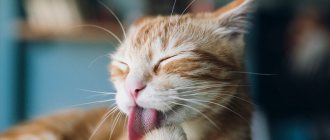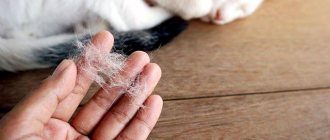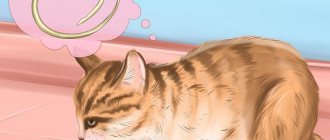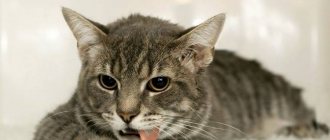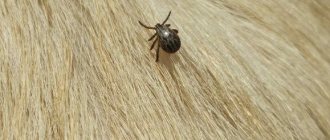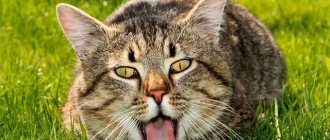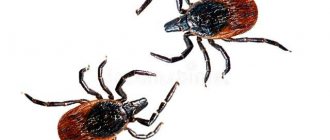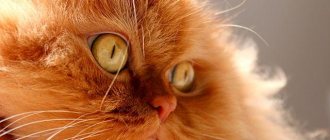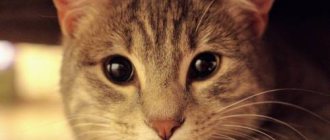It's no secret that cats often vomit hairballs, but sometimes the animal simply cannot regurgitate the hair. In such a situation, the pet requires the attention and help of the owner.
We will learn how to detect a trichobezoar in time, how you can remove hair from a cat’s stomach at home, and also analyze effective measures to prevent this problem.
Fur in a cat's stomach: symptoms
Signs of fur in a pet's stomach vary: from mild discomfort to serious problems with stool. Symptoms of illness:
- frequent constipation, problems with nutrition due to clogged intestines;
- change in the color characteristics of wool;
- decreased immunity;
- lethargic and sleepy state;
- the appearance of bloating, constant attempts to burp;
- cough.
The cat has a stomach ache due to gastrointestinal blockage
If there is fur in the body, owners often examine the kittens' teeth. If there are wool clots on the enamel, it means that some of them have entered the stomach. In such cases, you should urgently consult a doctor.
How to understand that a cat needs help
- The cat is lethargic, sleeps a lot, refuses food and active games, and hides in secluded places.
- Aggression in response to attempts to stroke and caress the pet.
- Sudden weight loss, deterioration of hair condition, hair loss.
- Hard, enlarged abdomen, loud “gurgling” in the abdomen.
- Frequent nausea, constipation, too hard stools, including those with blood, increased gas formation.
- An increase in body temperature as a consequence of the inflammatory process in the body.
What is the reason for the appearance and accumulation of hair in a cat’s stomach?
How to remove fleas from a cat at home
Cats themselves are fairly clean pets that take care of their fur on their own. To do this, they regularly use their language. Cats lick their fur, after which the plucked hairs fall into the oral cavity and then into the stomach. If the clump turns out to be small, it will easily leave the body after going to the toilet. In opposite cases, the wool gets stuck in the stomach and interferes with its stable functioning.
What problems arise from hair accumulation?
The main danger is that cat hair does not dissolve under the influence of gastric juice and is not digested. It can leave the body only in two ways:
- during defecation;
- with vomiting.
It is considered normal to regurgitate hair about 1-4 times a month. This process is most active during the molting period. The difficulty is that a cat cannot remove all the fur from the body on its own. Hairs can bunch up into dense clumps (trichobezoars) and block the lumen of the stomach, complicating the functioning of the gastrointestinal tract.
This entails the following complications:
- Malfunctions of the gastrointestinal tract. Trichobezoars are not broken down by enzymes of the stomach and intestines, which leads to the development of dyspeptic syndrome (vomiting, diarrhea, gas formation). The pet develops a feeling of false satiety and refuses to eat. In fact, the body is depleted, is under constant stress, and vitamin deficiency increases.
- Intestinal obstruction. Hairballs block the digestive tract. The cat cannot eat or go to the toilet normally and experiences pain. In serious cases, death can occur without surgical intervention.
- Gastritis. When there is constantly wool in the stomach, there is a continuous production of gastric juice, which contains hydrochloric acid. If the juice does not digest food, it gradually “eats away” the gastric mucosa.
Anorexia due to a false sense of satiety, constipation, impaired intestinal contractility, stomach discomfort, inflammatory processes - all this can be a consequence of a pet’s harmless love for self-licking.
The danger of hairballs
How to remove fleas from a kitten at home
Untimely treatment of pathology leads to the following consequences:
- the hairballs fill the stomach and give the animal a feeling of fullness, causing it to refuse food. This leads to a deficiency of vitamins and nutrients in the body;
- prolonged presence of villi in the stomach leads to eating disorders, bloating and acute pain, which are difficult to relieve with painkillers;
- Long-term presence of wool in the body can cause many infections and inflammatory processes.
Removing hair clots from a cat's stomach using herbs
Foreign bodies in the body lead to a deterioration in the general condition of cats: they lose the desire to frolic and play, and develop apathy and drowsiness.
Causes of hairball formation
The first and only reason is the notorious cat cleanliness. Licking helps the cat not only take care of its appearance, smoothing protruding hairs with a rough tongue, removing small dirt and foreign odors, but also relieves stress.
However, due to the structure of the tongue, the furry creature simultaneously swallows many dead and fallen hairs. Some pass through the gastrointestinal tract without any problems, but others can become tangled, forming dense lumps - bezoars.
They practically never occur in kittens. It's common for cats to become more self-grooming as they get older.
Long-haired breeds are primarily susceptible to the formation of hairballs in the gastrointestinal tract: Persian cats, Maine Coons. The problem is also relevant for overly stubborn short-haired “neaties”, since they swallow a significant amount of hairs.
Rules for breeding wool
A cat's eyesore: how to treat it at home
Before removing fur from a cat’s stomach at home, you should familiarize yourself with the main rules of the procedure.
- At the initial stages, you can try to remove hair from the stomach using traditional methods, for example, using green grass. After eating it, the cat will vomit and the foreign body will be expelled from the body.
- In advanced cases, special foods and medications are used. In parallel with therapy, you need to monitor the cat’s food and drink. Proper nutrition and plenty of fluids will help the wool clots leave the stomach quickly;
- For long-term constipation and intestinal obstruction, use Vaseline oil orally. It helps to relieve the animal's condition and soften the feces.
If home treatments do not help remove hair, you should urgently make an appointment with a veterinarian.
When can hairballs become dangerous?
Hairballs themselves are harmless. However, if your cat is wandering around the house and constantly vomiting with no sign of a hairball (especially if she has lost energy and doesn't want to eat), take her to the vet immediately. This may be a sign that the hairball has moved from the stomach to the intestines. This is a serious condition that should be treated immediately by a veterinarian.
You should take your cat to the vet if she has any of these cat hairball symptoms:
- Prolonged vomiting, vomiting, vomiting without hairball formation
- Loss of appetite
- Lethargy
- Feline constipation or diarrhea
- Excessive grass pecking
- Swollen or tender belly
How to help your pet
To understand how to help a cat spit out fur, you need to familiarize yourself with the various range of products that doctors recommend.
Paste
Specialized pastes are designed to dissolve and remove hair clots from the body of kittens. They consist of plant elements and ballast substances that penetrate the pets’ body and help regurgitate wool fibers. The paste helps restore stomach function, speed up metabolic processes and relieve inflammation. The product is mixed into the main feed once a day.
Special feed
Today, many manufacturers create special foods that help regurgitate balls of hair in the stomach. The main components of such food are oil and plant fiber. They coat the gastric mucosa, soften stool and facilitate its exit from the body. If your cat cannot regurgitate fur, what to do:
- calm the animal;
- give him the main food;
- add a small amount of special plant food and feed your pet.
If constipation occurs for several days, specialized food is used in its pure form.
Vaseline oil
Vaseline oil acts as a laxative. It softens feces and promotes their rapid exit from the cat’s body. The product is administered using a syringe. The optimal dose is 3-4 ml. To give the injection, you need to wait until the pet is in a relaxed state.
Vaseline oil for cleansing the gastrointestinal tract of a cat with blockage
Special home herb
The product is sold in many pet stores in seed form. It is recommended to germinate them at home in special pots, and then use them to regurgitate hair from the stomach of cats.
For your information! The herbal mixture is endowed with useful vitamins and minerals that normalize the functioning of the stomach.
Characteristic symptoms
If hairballs are not eliminated from the stomach naturally and the cat has swallowed enough of them, the following signs can help determine that something is wrong with the animal:
Because of this problem, the animal may begin to cough.
- Loss of appetite. The cat's appetite decreases significantly; the animal may even refuse its favorite treat or just try it. This is due to the fact that due to the fact that the stomach is full of wool, the brain receives signals of satiety, but the glucose level does not increase, as after a normal meal.
- Dullness and excessive hair loss. It is a consequence of malnutrition and the body not receiving essential nutrients.
- Dry cough, frequent vomiting. So, the cat tries to independently pull out and remove the fur accumulated in the digestive organs.
- Lethargy, drowsiness. A healthy cat should be active and playful. If previously a pet could play and run around the house all day long, then when fur accumulates in the stomach, its activity decreases significantly.
- Chronic constipation. If the cat does not regurgitate the hair and it does not leave the body naturally, a blockage occurs in the digestive tract. If the intestines are not removed and cleaned in a timely manner, necrotic processes will soon develop in the area where fur accumulates.
- Accumulation of hairs on fangs.
Recommended products for treating and removing hair
Veterinary pharmacies sell special complexes that contain herbal ingredients and help cleanse the stomach of pets.
Phytocomplex "Nature"
Vitamin plant complex "Nature" contains ballast components, milk sugar and malt. These components normalize the acid-base balance of the intestines, forming a belch, which rids the kitten’s body of a foreign body. The tableted product is added to food or given to the animal in its pure form.
Prophylactic mixture "Nutri-Vet"
The drug consists of omega-3 acids, vitamins and beneficial macroelements. They enrich the stomach with nutrients and relieve it from further blockages. The mixture is used 1-2 times a day as an additive to food or as an independent preparation. She helps the cat regurgitate foreign matter.
Beaphar Bits Mix
The beneficial pads contain malt paste, which helps cleanse the digestive system and remove foreign objects from the intestines. The products are allowed to be used for preventive purposes. The pads are considered to be a universal remedy, as they are suitable for newborns and adult pets.
Important! In addition to their cleansing properties, they have an immunostimulating effect.
Vitamin supplement
The drug consists of vitamins E, omega-3 acids and fatty plant components. These substances have a laxative and cleansing effect, normalize metabolic processes and restore the functioning of the gastrointestinal tract. The additive is used during pathology, as well as for preventive purposes.
Cliny
Cliny spread consists of malt extract, fiber and corn oil. These components normalize digestion, improve appetite and help soften stool.
Paste for removing hair from a pet's body
Vitamin complex Malt-Kiss
A fortified product containing malt and ballast substances. The product restores the acid-base balance of the stomach and promotes the rapid release of hair clots from the body.
The cat swallows fur. What to do?
Olesya Smirnova
Many cat owners periodically have to deal with the problem of removing hair from the animal's gastrointestinal tract. Thanks to the achievements of modern medicine and industry, these days it is possible to effectively and quickly help a pet and alleviate its condition. But what is the best way to do this? And is it possible to prevent the formation of hairballs in the stomach and intestines?
Not a harmless hygiene procedure
Cats are very clean animals; they wash themselves more than ten times a day. With the help of licking, they keep the fur coat and skin clean: they remove parasites, various contaminants, and dead hairs, thereby preventing the appearance of tangles and promoting fur renewal. By washing, cats also get rid of their own odors, which helps them when hunting (domestic cats do this instinctively). But licking fur is not only a cleansing process. Washing also has other important functions. It helps the cat relieve psycho-emotional stress, control body temperature, and protect the fur from excess moisture. It's no wonder why our mustachioed friends wash themselves so thoroughly and often. Saliva promotes effective licking of a cat's fur. Thanks to its special composition, it is an excellent cleaning agent. Another helper of a cat is its tongue. Its rough surface is covered with numerous horny “hairs” (papillaries). These pointed tubercles are curved towards the root of the tongue and therefore all the hairs caught by them are directed into the animal’s mouth. The cat cannot spit out hair that gets on the tongue and swallows it. The digestive system is not able to digest them. A small amount of fur can be released from the stomach along with vomit, and from the intestines - with feces. The hairs that have not been removed accumulate and fall into short thick capsules - trichobezoars. Several factors contribute to the formation of trichobezoars. The most important of them is molting. During this period, a large amount of hair falls out, which the cat licks and swallows. Increased hair loss also occurs during certain animal diseases or after suffering stress. The problem of trichobezoars also often occurs in long-haired cats; in old animals with reduced gastrointestinal motility; in overweight cats; in cats with metabolic disorders and hormonal disorders; in cats with an unbalanced diet (with a lack of nutrients, hair begins to fall out more intensely); in cats infected with parasites (due to increased licking of fur). Hairballs formed in the stomach or intestines threaten the cat's health with unpleasant and painful conditions that can be life-threatening. To avoid trouble, you need to know the symptoms of trichobezoars, carefully monitor changes in the cat’s condition and be ready to help her in a timely manner.
Ingested fur is a serious problem
Let us note right away that hairs licked by a cat can accumulate not only in the gastrointestinal tract, but also behind the lower fangs. The animal is not capable of getting the hairs out of there on its own, and here a person must come to its aid. Otherwise, the hairs may grow into the gums, and this already threatens an inflammatory process. The cat usually tries to get rid of trichobezoars that form in the stomach on its own. A dry cough helps relieve the animal's discomfort. It also helps induce vomiting, from which one lump is usually removed. A cat that has freed its stomach from trichobezoars feels much better. However, when vomiting (if it is profuse and contains pieces of food), the cat loses fluid and electrolytes, which need to be replenished. This can be done with the help of special medications and diet. Another problem that trichobezoars bring with them is a distorted appetite. On the one hand, it’s high time to take another portion of food, the concentration of glucose in the blood has decreased, and the animal feels hungry. On the other hand, a stomach filled with trichobezoars signals that it is full. The food doesn't fit - there's nowhere to go! So the cat is tossing around, chewing grass in the hope of inducing vomiting. Hair capsules formed in the stomach can cause gastritis in a cat. This disease is characterized by disruption of the basic functions of the stomach. In acute gastritis, the cat suffers from frequent bouts of vomiting and increased salivation, general weakness, lack of appetite, and loose stools. Accumulations of fur from the cat's stomach move further into the intestines, and this causes constipation. The animal becomes lethargic and apathetic, refuses to eat, and as a result loses weight. The cat suffers from vomiting, bloating and tenderness of the abdomen, and fever. When attempting to defecate, the cat experiences tension and pain, and may meow pitifully. Constipation caused by trichobezoars in some cases causes gastrointestinal obstruction (ileus). Accumulated hair mechanically injures the stomach and intestines, causing spasms and acute expansion of these organs. In this case, circulatory disorders occur, inhibition of intestinal motility (atony) and necrosis of its walls, and intoxication of the body with decay products develops. Ileus is accompanied by apathy and fever. As the disease worsens and poisoning begins, the cat develops drooling, nausea and vomiting, abdominal pain, loss of coordination of movements, convulsions, and coma occurs. If the animal is not operated on in time, it faces death. If you notice that your pets are feeling unwell, you should not self-medicate. Only a specialist can assess the reasons for a cat’s poor health, and the surest way to help your pet is to contact a veterinarian.
Means for removing trichobezoars
One of the most effective means of combating trichobezoars is a special paste for hair removal. The drug helps remove swallowed hairballs from the gastrointestinal tract naturally, and also prevents the formation of new accumulations, constipation and intestinal blockage. All this is achieved thanks to the indigestible fiber (ballast substances), vegetable oil, TGOS (transgalactooligosaccharide), and malt included in the paste. Hair removal paste helps to cope not only with the problem of hairballs. Its value lies in the fact that it increases appetite, improves digestion and absorption of nutrients. To achieve good results, the drug should be given during periods of shedding, preferably daily, while observing the dosage indicated in the instructions. The paste can be offered to your pet in its pure form before meals or mixed with food. You can also smear the drug on the cat’s face and paws so that it eats it when licking it. This method is good if the cat refuses the paste. Unfortunately, hair removal paste does not always help. It is ineffective if there is too much shedding - in this case, you first need to look for the cause of the increased hair loss. Also, the drug will not help with blockage of the stomach or intestines, with volvulus, as well as with coprostasis (stagnation of feces in the lower parts of the large intestine). If your animal has chronic diseases and you doubt whether you can give him paste, consult your doctor. Owners of cats prone to allergies also need to be careful - the drug can cause unwanted reactions. An analogue of the paste also exists in the form of tablets. Their action is also aimed at enveloping and softening feces, gently enhancing peristalsis, and quickly and painlessly removing fecal plugs. Manufacturers can add extracts of medicinal plants, a natural mineral complex, bioenzymes, fortified supplements and other beneficial substances to the tablets. Another non-medicinal product is a special dry food for hair removal. It is recommended to give it to cats in addition to their regular diet. The food contains indigestible fiber, which reduces the likelihood of accumulation of trichobezoars in the gastrointestinal tract and helps to quickly and easily remove hair from the body. The composition also includes digestible fiber - they help maintain healthy intestinal microflora. Special treats for cats can serve as a supplement to the diet and at the same time a means of preventing and removing hairballs. They are pillows in a crispy shell with the taste of meat, salmon or chicken. Inside the treat there is a “medicinal” filling - a paste for removing fur. There is another, simple and affordable means of removing hairballs - regular pharmacy petroleum jelly or special petroleum jelly for cats. These drugs have a laxative effect and help painlessly clear the intestines of foreign bodies and eliminate constipation (if any).
You need to give the oil in the amount of 1 teaspoon per day to a kitten and 1 tablespoon to an adult cat (it is convenient to use a syringe without a needle). If giving oil turns into fights without rules, it is better to abandon this procedure: if it gets into the respiratory tract, the cat will develop aspiration pneumonia. Taking the drug internally can be replaced by external use: during the molting period, lubricate the cat’s paws for several days in a row. When the animal licks itself, the oil will enter the body and provide the necessary effect.
Vaseline oil cannot be called a universal and ideal way to combat trichobezoars. It is not recommended for long-term use, since intestinal atony may occur, as well as the absorption of nutrients from the gastrointestinal tract may be impaired and hypovitaminosis A, E, K may develop. In addition, the oil has some contraindications (for example, inflammatory processes in the abdominal cavity, pregnancy, intestinal obstruction).
The best treatment is prevention
There are several ways to prevent the formation of hairballs in the gastrointestinal tract, and it is advisable to use them in combination. The first of them is constant hygienic care of the cat's fur. Grooming allows you to reduce the number of dead hairs that, when licked, could get into the pet’s gastrointestinal tract. Hair care should include combing, massage, and washing. In some cases (in particular, to get rid of tangles), a haircut is also required. The greatest attention, especially during periods of molting, should be given to combing. It can be done using a brush, comb, comb, or special mitten. The choice of tool depends on the type of cat's fur. The second way to prevent the formation of trichobezoars is to eat sprouted wheat, oats, or special grass purchased at a pet store. These products make it easier for your cat to regurgitate hair. Moreover, green treats bring invaluable benefits to the animal, as they contain amino acids, vitamins, microelements and other beneficial substances. They help strengthen the body's resistance to infections, activate digestive function, normalize the activity of the nervous system, etc. And finally, the third way is to provide your cat with a balanced diet. High-quality food and a properly formulated diet help prevent hair breakage and hair loss, make the coat shiny and the skin healthy. The fur coat looks luxurious if the cat receives sufficient vitamins, microelements, fatty acids, and high-quality protein with food. As you can see, there are many means of preventing the formation of hairballs and removing them from the gastrointestinal tract. Stick with the ones that best suit your pet and you will forget about the problem of trichobezoars. Health to your four-legged friend!
Dry food
Dry food is no less popular in the fight against pathology. They contain useful macroelements, minerals and vitamins that normalize the functioning of the digestive system.
Purina Cat Chow Special Care Hairball Control
Dry food for removing hair from cats and cats is intended for adult pets. The product has a positive effect on gastrointestinal motility, which helps pets regurgitate fur. The composition includes vitamins, minerals and plant substances.
Hill's Science Plan Feline Adult Hairball Control
A product designed to remove hair from the digestive system. Contains antioxidants, minerals, fiber. The substances have a cleansing and laxative effect.
Savarra Adult Cat Hairball Control
Dry food helps restore the functioning of the digestive system and cleanse the gastrointestinal tract of foreign bodies. The composition includes turkey meat, flax seeds, herbal ingredients. The products are recommended for use in feeding adult cats.
Gimpet Malt-Soft
The product is designed to remove hair from the cat's body. The food is designed for adult pets. It contains plant substances, vitamins and minerals. They regulate the functioning of the gastrointestinal tract and have a preventive effect.
Kittymalt Hairball Remedy Paste, 8 in 1 Excel
The drug contains mineral oils, malt syrup and vitamin E. It has a tonic and laxative effect on the body, helping to remove foreign elements from it.
Pet care
It is worth remembering the rules for caring for your cat during therapy. If the cat cannot regurgitate fur during treatment, what to do and how to remove it:
- provide the animal with plenty of fluids with added oils;
- comb the cat's shedding fur so that she does not do it on her own and does not expose her intestines to another blockage;
- Monitor your pet’s diet and feed it food containing plant components. Such food helps to fill up and enrich the intestines with useful substances.
To avoid infection, it is recommended to monitor your cat's hygiene.
Main symptoms
Even a small kitten who is just learning to lick his fur coat can regurgitate a lump of fur that is filling his stomach. For an adult animal, the norm is to clean the stomach from 1 to 6 times a month, depending on the length of the fur and the age of the animal.
The owner should be wary if the cat exhibits the following signs:
- constipation or rare hard stools with pieces of fur;
- daily vomiting of hair;
- temperature increase;
- blood, mucus, shreds of fur in vomit;
- inability to regurgitate the trichobezoar on their own;
- cough;
- refusal to eat due to stomach fullness;
- salivation;
- swollen, painful on palpation abdomen.
The fur becomes unkempt and disheveled, but the cat does not wash or lick itself. She stops being active and tends to hide in a secluded corner.
Preventive measures
To avoid re-clogging, doctors advise using special pastes and mineral supplements during shedding. This product helps remove villi from the stomach in a short time by stimulating regurgitation. In addition, it is worth adding food rich in sulfur, magnesium, and folic acid to your cat’s diet.
Hairballs in a cat's body are a common problem that animals encounter during the shedding process. A timely response to pathology on the part of the owner helps prevent the development of complications and the inflammatory process.
Tool for combing the hair of cats and dogs My Rules (deshedder, comb, slicker) size M
711 ₽ More details
History of Russia for children. Book Butromeev V.P. | Butromeev Vladimir Petrovich
888 ₽ More details
Muzzles for dogs
How to Diagnose Cat Hairballs?
There are many ways a veterinarian can diagnose hairballs in cats. This may be an x-ray or a physical examination. In extreme cases, surgery may be required to remove the hairball if it has become particularly large; this can be expensive in terms of veterinary bills.
Constant vomiting (without signs of a hairball) and lethargy can also be signs of asthma. The veterinarian should be able to determine the cause. Either way, you will discover your cat's health problem and address it before it gets worse.
It is normal for your cat to tear up hairballs from time to time. You should only start to worry if your cat is vomiting hairballs every few weeks or continuously for more than 48 hours - this is a sign that too much hair is getting into the intestines.
